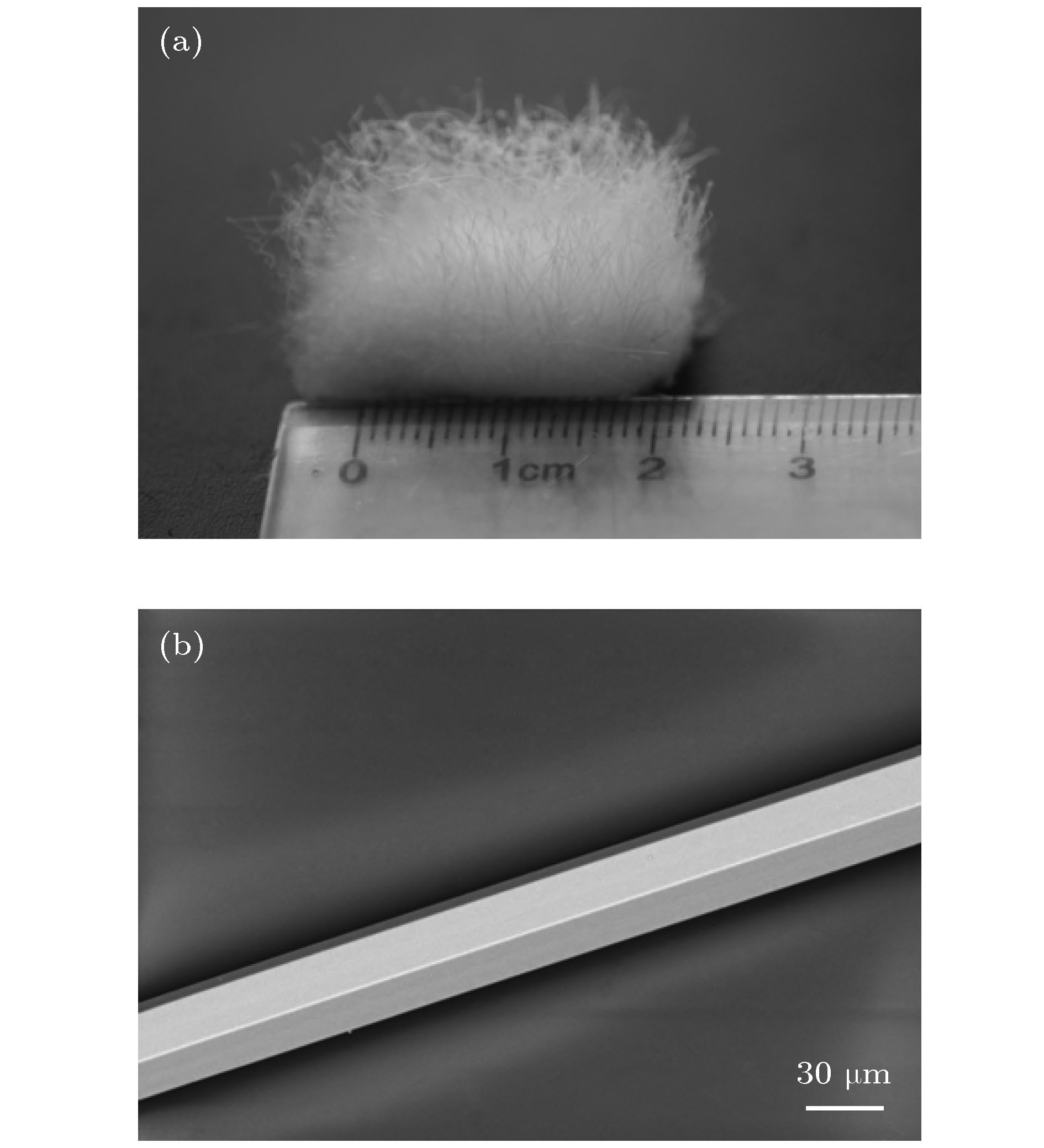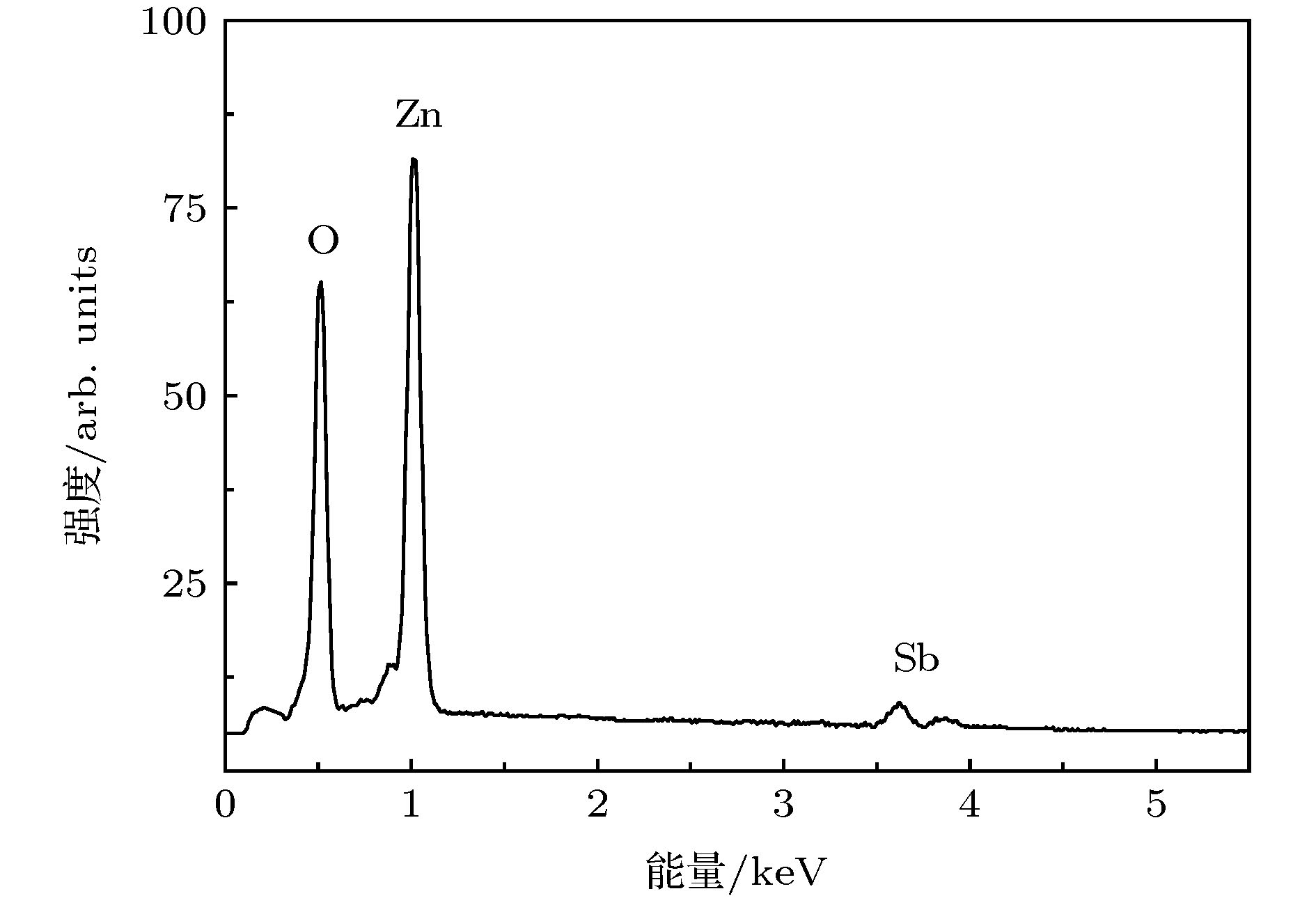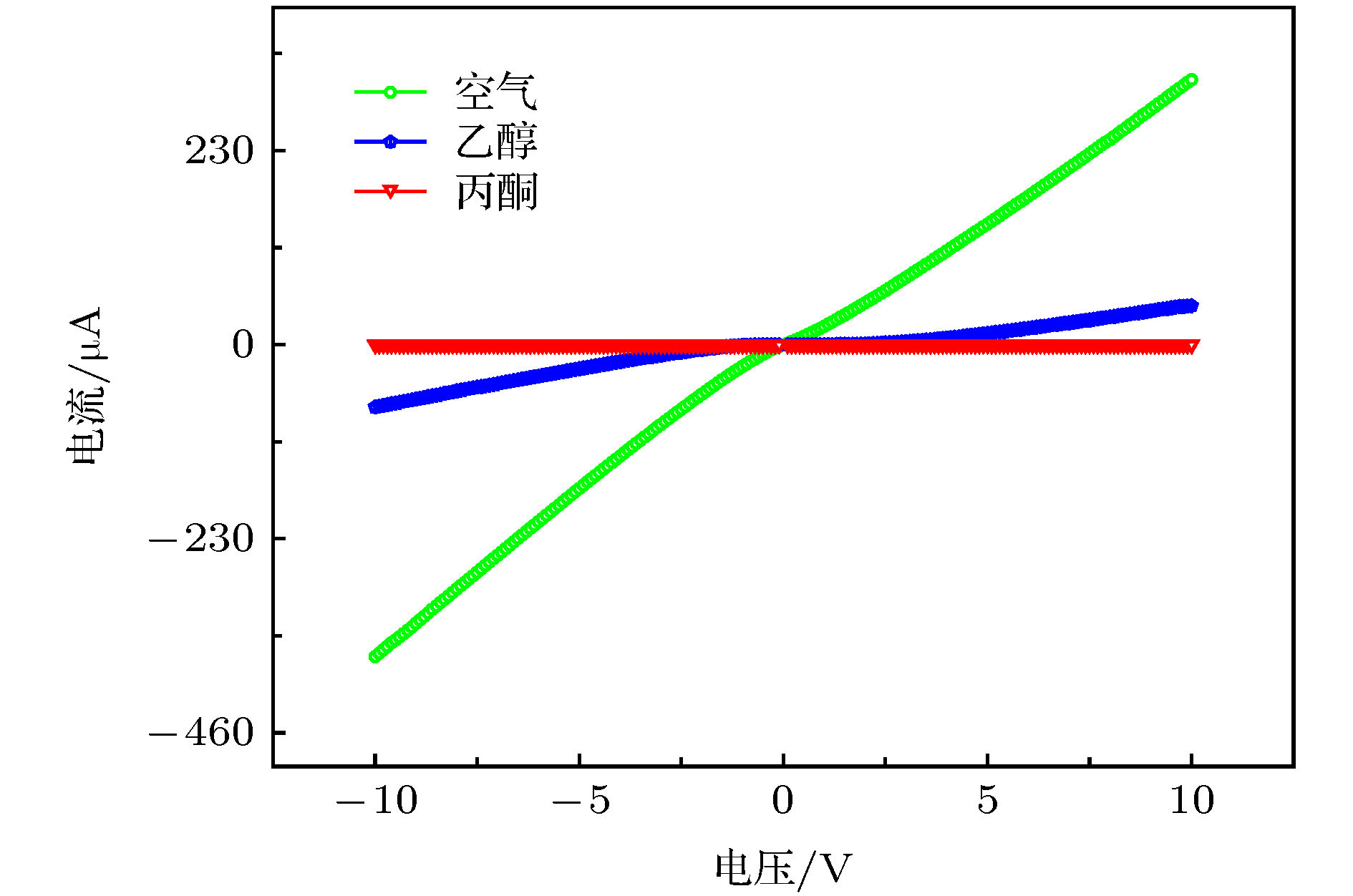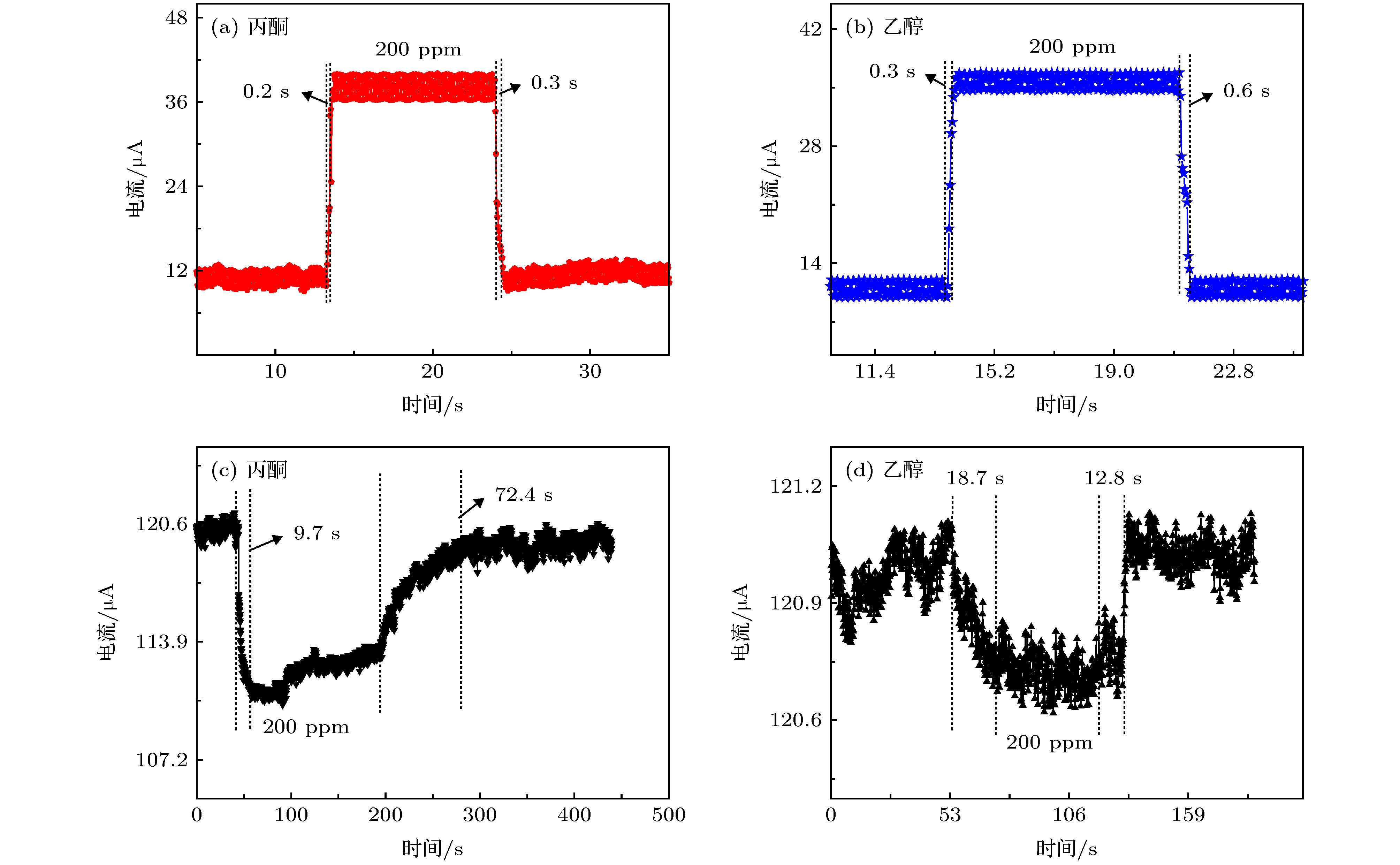-
通过使用化学气相沉积法, 成功制备出超长、大尺寸的Sb掺杂ZnO微米线. 基于非平衡电桥原理, 利用单根Sb掺杂ZnO微米线作为非平衡电桥的一个桥臂, 制作出了可以在室温环境下工作的气敏传感器原型器件. 结果表明: 室温下测得该传感器对20, 50, 100和200 ppm (1 ppm = 10–6)不同浓度的丙酮及乙醇气体的响应-恢复曲线均呈现为矩形形状, 在空气及被测气体中均有稳定的电流值, 并随着探测气体浓度的增大, 器件的响应值也在逐渐增加. 此外, 还发现器件对丙酮气体具有更好的选择性, 当丙酮气体浓度为200 ppm时, 该传感器的响应时间为0.2 s, 恢复时间为0.3 s, 响应度高达243%. 通过与普通电导式气敏传感器对比发现, 采用这种非平衡电桥结构传感器可以明显地提高响应度, 使响应和恢复时间更快. 此外, 还研究了器件的气体探测机理.
-
关键词:
- 化学气相沉积 /
- Sb掺杂ZnO微米线 /
- 非平衡电桥 /
- 气敏传感器
Zinc oxide (ZnO) is a wide direct band gap (3.37 eV) II-VI semiconductor material with a wide range of applications in light emitting devices, solar cells, field emission devices, gas sensors, etc. Over the past decades, metal oxide semiconductors have been investigated extensively for sensing various types of vapors and toxic gases. Among the various metal oxides for gas sensing applications, ZnO is one of the potential materials for high response, stability and sensitivity to volatile organic gases. At present, the ZnO-based gas sensor has a relatively high operating temperature. However, the stability and lifetime of gas sensors operating under high temperature conditions with a long term will be greatly reduced. In addition, the power consumption of gas sensors is also significantly increased. Furthermore, there can exist the potential of explosion when gas sensors are used to detect the flammable gases at high temperature. Therefore, it is necessary to improve the sensing properties and reduce the operating temperature of gas sensors. In this paper, ultra-long, large-sized Sb doped ZnO microwires are successfully prepared by using chemical vapor deposition. The gas sensor is based on the principle of non-balance electric bridge, and a single Sb doped ZnO microwire is used as a bridge arm R4 of non-balance electric bridge to produce a gas sensor that can work at room temperature. The results show that the response-recovery curves of sensors at the acetone and ethanol concentrations of 20 ppm, 50 ppm, 100 ppm and 200 ppm (1 ppm = 10–6) are rectangular at room temperature, and have stable current values in air and measured gas, and the response value of the device gradually increases with gas concentration increasing. Furthermore, the detection of acetone and ethanol gas reveal that the device has better selectivity for acetone gas. The response of the gas sensor to 200 ppm acetone is about 243%, with response and recovery time of 0.2 s and 0.3 s, respectively. Compared with the traditional resistive gas sensor, this non-balanced electric bridge sensor has high response, fast response and recovery time. In addition, the sensing mechanism of the device is also studied.-
Keywords:
- chemical vapor deposition /
- Sb doped ZnO microwires /
- non-balance electric bridge /
- gas sensor
[1] 李酽, 李娇, 陈丽丽, 连晓雪, 朱俊武 2018 物理学报 67 140701
 Google Scholar
Google Scholar
Li Y, Li J, Chen L L, Lian X X, Zhu J W 2018 Acta Phys. Sin. 67 140701
 Google Scholar
Google Scholar
[2] Yang X, Dong L, Shan C X, Sun J L, Zhang N, Wang S P, Jiang M M, Li B H, Xie X H, Shen D Z 2017 Adv. Mater. 29 1602832
 Google Scholar
Google Scholar
[3] 冯秋菊, 许瑞卓, 郭慧颖, 徐坤, 李荣, 陶鹏程, 梁红伟, 刘佳媛, 梅艺赢 2014 物理学报 63 168101
 Google Scholar
Google Scholar
Feng Q J, Xu R Z, Guo H Y, X K, Li R, Tao P C T, Liang H W, Liu J Y, Mei Y Y 2014 Acta Phys. Sin. 63 168101
 Google Scholar
Google Scholar
[4] Mourad S, Ghoul J E, Omri K, Khirouni K 2019 Chin. Phys. B 28 047701
 Google Scholar
Google Scholar
[5] 刘姿, 张恒, 吴昊, 刘昌 2019 物理学报 68 107301
 Google Scholar
Google Scholar
Liu Z, Zhang H, Wu H, Liu C 2019 Acta Phys. Sin. 68 107301
 Google Scholar
Google Scholar
[6] Wei A, Wang Z, Pan L H, Li W W, Xiong L, Dong X C, Huang W 2011 Chin. Phys. Lett. 28 080702
 Google Scholar
Google Scholar
[7] 胡杰, 邓霄, 桑胜波, 李朋伟, 李刚, 张文栋 2014 物理学报 63 207102
 Google Scholar
Google Scholar
Hu J, Deng X, Sang S B, Li P W, Li G, Zhang W D 2014 Acta Phys. Sin. 63 207102
 Google Scholar
Google Scholar
[8] Liang J, Yang R, Zhu K, Hu M 2018 J. Mater. Sci. Mater. Electron. 29 3780
 Google Scholar
Google Scholar
[9] Shao C, Chang Y, Long Y 2014 Sens. Actuators B 204 666
 Google Scholar
Google Scholar
[10] Kim H J, Lee J H 2014 Sens. Actuators B 192 607
 Google Scholar
Google Scholar
[11] Feng Q J, Shi X C, Xing Y, Li T T, Li F, Pan D Z, Liang H W 2018 J. Alloys Compd. 739 298
 Google Scholar
Google Scholar
[12] Gu F B, You D, Wang Z H, Han D M, Guo G S 2014 Sens. Actuators B 204 342
 Google Scholar
Google Scholar
[13] Zhang P S, Pan G F, Zhang B Q, Zhen J L, Sun Y C 2014 Mater. Res. 17 817
 Google Scholar
Google Scholar
[14] Tian S, Yang F, Zeng D, Xie C 2012 J. Phys. Chem. C 116 10586
 Google Scholar
Google Scholar
[15] Li X W, Wang C, Guo H, Sun P, Liu F, Liang X, Lu G 2015 ACS Appl. Mater. Interfaces 7 17811
 Google Scholar
Google Scholar
[16] Alexiadou M, Kandyla M, Mousdis G, M. Kompitsas 2017 Appl. Phys. A 123 262
[17] Hsueh T J, Hsu C L, Chang S J, Chen I C 2007 Sens. Actuators B 126 473
 Google Scholar
Google Scholar
[18] Wang T, Xu S, Hu N, Hu J, Huang D, Jiang W, Wang S, Wu S, Zhang Y, Yang Z 2018 Sens. Actuators B 255 1006
 Google Scholar
Google Scholar
[19] Moreau W R 1989 Eur. J. Phys. 10 286
 Google Scholar
Google Scholar
[20] Castro H F, Correia V, Pereira N, Costab P, Oliveiraa J, Lanceros-Méndez S L 2018 Addit. Manuf. 20 119
 Google Scholar
Google Scholar
-
图 5 室温条件下传感器在不同浓度丙酮和乙醇气体中的响应和恢复曲线 (a)丙酮; (b)乙醇; (c), (d)室温下传感器对不同浓度丙酮及乙醇气体的响应度曲线
Fig. 5. Response and recovery curves of the gas sensor to different concentrations of acetone (a) and (b) ethanol at room temperature; (c), (d) the response of the gas sensor to different concentrations of acetone and ethanol at room temperature.
-
[1] 李酽, 李娇, 陈丽丽, 连晓雪, 朱俊武 2018 物理学报 67 140701
 Google Scholar
Google Scholar
Li Y, Li J, Chen L L, Lian X X, Zhu J W 2018 Acta Phys. Sin. 67 140701
 Google Scholar
Google Scholar
[2] Yang X, Dong L, Shan C X, Sun J L, Zhang N, Wang S P, Jiang M M, Li B H, Xie X H, Shen D Z 2017 Adv. Mater. 29 1602832
 Google Scholar
Google Scholar
[3] 冯秋菊, 许瑞卓, 郭慧颖, 徐坤, 李荣, 陶鹏程, 梁红伟, 刘佳媛, 梅艺赢 2014 物理学报 63 168101
 Google Scholar
Google Scholar
Feng Q J, Xu R Z, Guo H Y, X K, Li R, Tao P C T, Liang H W, Liu J Y, Mei Y Y 2014 Acta Phys. Sin. 63 168101
 Google Scholar
Google Scholar
[4] Mourad S, Ghoul J E, Omri K, Khirouni K 2019 Chin. Phys. B 28 047701
 Google Scholar
Google Scholar
[5] 刘姿, 张恒, 吴昊, 刘昌 2019 物理学报 68 107301
 Google Scholar
Google Scholar
Liu Z, Zhang H, Wu H, Liu C 2019 Acta Phys. Sin. 68 107301
 Google Scholar
Google Scholar
[6] Wei A, Wang Z, Pan L H, Li W W, Xiong L, Dong X C, Huang W 2011 Chin. Phys. Lett. 28 080702
 Google Scholar
Google Scholar
[7] 胡杰, 邓霄, 桑胜波, 李朋伟, 李刚, 张文栋 2014 物理学报 63 207102
 Google Scholar
Google Scholar
Hu J, Deng X, Sang S B, Li P W, Li G, Zhang W D 2014 Acta Phys. Sin. 63 207102
 Google Scholar
Google Scholar
[8] Liang J, Yang R, Zhu K, Hu M 2018 J. Mater. Sci. Mater. Electron. 29 3780
 Google Scholar
Google Scholar
[9] Shao C, Chang Y, Long Y 2014 Sens. Actuators B 204 666
 Google Scholar
Google Scholar
[10] Kim H J, Lee J H 2014 Sens. Actuators B 192 607
 Google Scholar
Google Scholar
[11] Feng Q J, Shi X C, Xing Y, Li T T, Li F, Pan D Z, Liang H W 2018 J. Alloys Compd. 739 298
 Google Scholar
Google Scholar
[12] Gu F B, You D, Wang Z H, Han D M, Guo G S 2014 Sens. Actuators B 204 342
 Google Scholar
Google Scholar
[13] Zhang P S, Pan G F, Zhang B Q, Zhen J L, Sun Y C 2014 Mater. Res. 17 817
 Google Scholar
Google Scholar
[14] Tian S, Yang F, Zeng D, Xie C 2012 J. Phys. Chem. C 116 10586
 Google Scholar
Google Scholar
[15] Li X W, Wang C, Guo H, Sun P, Liu F, Liang X, Lu G 2015 ACS Appl. Mater. Interfaces 7 17811
 Google Scholar
Google Scholar
[16] Alexiadou M, Kandyla M, Mousdis G, M. Kompitsas 2017 Appl. Phys. A 123 262
[17] Hsueh T J, Hsu C L, Chang S J, Chen I C 2007 Sens. Actuators B 126 473
 Google Scholar
Google Scholar
[18] Wang T, Xu S, Hu N, Hu J, Huang D, Jiang W, Wang S, Wu S, Zhang Y, Yang Z 2018 Sens. Actuators B 255 1006
 Google Scholar
Google Scholar
[19] Moreau W R 1989 Eur. J. Phys. 10 286
 Google Scholar
Google Scholar
[20] Castro H F, Correia V, Pereira N, Costab P, Oliveiraa J, Lanceros-Méndez S L 2018 Addit. Manuf. 20 119
 Google Scholar
Google Scholar
计量
- 文章访问数: 13025
- PDF下载量: 93
- 被引次数: 0













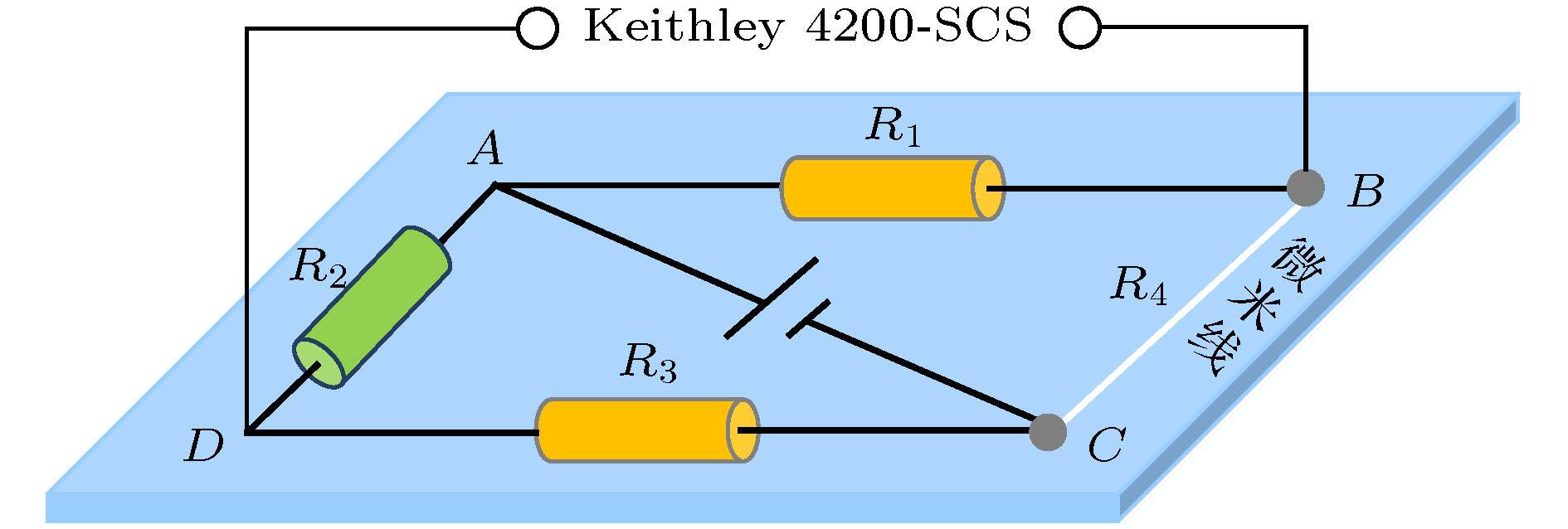
 下载:
下载:
